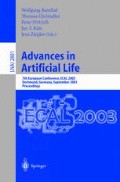Abstract
We demonstrate a simple artificial chemistry environment in which two small evolutionary transitions from the simplest self-replicators to larger ones are observed. The replicators adapt to increasingly harsh environments, where they must synthesise the components they need for replication. The evolution of a biosynthetic pathway of increasing length is thus achieved, through the use of simple chemical rules for catalytic action.
Access this chapter
Tax calculation will be finalised at checkout
Purchases are for personal use only
Preview
Unable to display preview. Download preview PDF.
References
Cairns-Smith, A.G.: Seven clues to the origin of life. Cambridge University Press, Cambridge (1985)
Channon, A.: Improving and still passing the ALife test: Component-normalised activity statistics classify evolution in Geb as unbounded. In: Standish, R., Bedau, M.A., Abbass, H.A. (eds.) Proc. Artificial Life VIII, pp. 173–181. MIT Press, Cambridge (2002)
Dittrich, P., Ziegler, J., Banzhaf, W.: Artificial chemistries - a review. Artificial Life 7(3), 225–275 (2001)
Fontana, W., Buss, L.W.: What would be conserved if “the tape were played twice”? Proc. Nat. Acad. Sci. 91, 757–761 (1994)
Horowitz, N.H.: On the evolution of biochemical synthesis. Proc. Nat. Acad. Sci. 31, 153–157 (1945)
Hutton, T.J.: Evolvable self-replicating molecules in an artificial chemistry. Artificial Life 8(4), 341–356 (2002)
Joyce, G.F., Orgel, L.: Prospects for understanding the origin of the RNA world. In: Gesteland, R.F., Cech, T.R., Atkins, J.F. (eds.) The RNA World, pp. 49–77. Cold Spring Harbor Laboratory Press, New York (1999)
Lenski, R.E., Ofria, C., Pennock, R.T., Adami, C.: The evolutionary origin of complex features. Nature 423, 139–144 (2003)
Margulis, L.: Symbiosis in Cell Evolution. Freeman, New York (1981)
Mayer, B., Rasmussen, S.: Dynamics and simulation of micellar selfreproduction. International Journal of Modern Physics C 11(4), 809–826 (2000)
McMullin, B.: John von Neumann and the evolutionary growth of complexity: Looking backwards, looking forwards. Artificial Life 6(4), 347–361 (2000)
Ono, N., Ikegami, T.: Artificial chemistry: Computational studies on the emergence of self-reproducing units. In: Kelemen, J., Sosík, P. (eds.) Proc. European Conference on Artificial Life, pp. 186–195. Springer, Heidelberg (2001)
Orgel, L.E.: Selection in vitro. Proceedings of the Royal Society B 205, 435–442 (1979)
Paun, G.: Membrane Computing. An Introduction. Springer, Berlin (2002)
Sayama, H.: A new structurally dissolvable self-reproducing loop evolving in a simple cellular automata space. Artificial Life 5(4), 343–365 (1999)
Suzuki, Y., Tanaka, H.: Chemical evolution among artificial proto-cells. In: Bedau, M.A., McCaskill, J.S., Packard, N.H., Rasmussen, S. (eds.) Proc. Artificial Life VII, pp. 54–64. MIT Press, Cambridge (2000)
Szathmáry, E., Demeter, L.: Group selection of early replicators and the origin of life. Journal of Theoretical Biology 128, 463–486 (1987)
Szostak, J.W., Bartel, D.P., Luisi, P.L.: Synthesizing life. Nature 409, 387–390 (2001)
Taylor, T.: Creativity in evolution: Individuals, interactions and environment. In: Bentley, P., Corne, D. (eds.) Proceedings of the AISB 1999 Symposium on Creative Evolutionary Systems. The Society for the Study of Artificial Intelligence and Simulation of Behaviour, Morgan Kaufman, San Francisco (1999)
The IBM Blue Gene team. Blue gene: A vision for protein science using a petaflop supercomputer. IBM Systems Journal, 40(2) (2001)
Wilke, C.O., Adami, C.: The biology of digital organisms. Trends in Ecology and Evolution 17(11), 528–532 (2002)
Author information
Authors and Affiliations
Editor information
Editors and Affiliations
Rights and permissions
Copyright information
© 2003 Springer-Verlag Berlin Heidelberg
About this paper
Cite this paper
Hutton, T.J. (2003). Simulating Evolution’s First Steps. In: Banzhaf, W., Ziegler, J., Christaller, T., Dittrich, P., Kim, J.T. (eds) Advances in Artificial Life. ECAL 2003. Lecture Notes in Computer Science(), vol 2801. Springer, Berlin, Heidelberg. https://doi.org/10.1007/978-3-540-39432-7_6
Download citation
DOI: https://doi.org/10.1007/978-3-540-39432-7_6
Publisher Name: Springer, Berlin, Heidelberg
Print ISBN: 978-3-540-20057-4
Online ISBN: 978-3-540-39432-7
eBook Packages: Springer Book Archive

